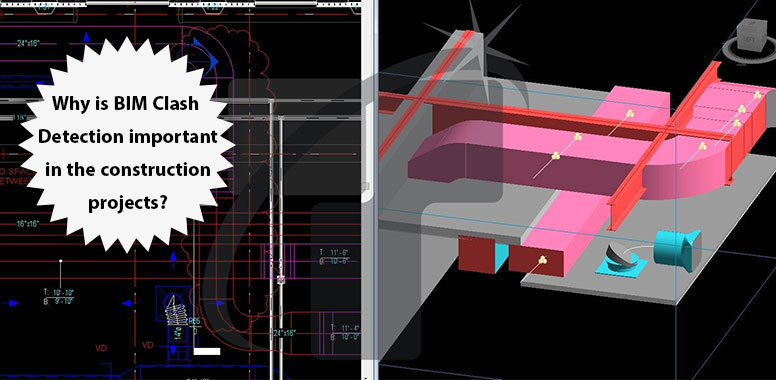Why is BIM Clash Detection important in the construction projects?

Overview
BIM adoption is booming in the construction industry due to its benefit of identifying the clashes at the very early stage in the construction process which makes the project model for the contractors and owners much easier and less time consuming. Clashes in the construction process occur when the parts or components that make up the built asset is not appropriately coordinated and makes a place for conflict to occur.
Clash Detection Services is a component of the BIM process where the construction professionals such as contractors, sub-contractors, etc. can identify the clashes in the construction process and resolve them within Architectural, Structural and MEP discipline. 3D BIM Model helps to resolve clashes in less time through an automated approach.
Clash Detection Software such as Navisworks helps us to identify, review and report clashes from the 3D BIM Model which is created by combining a model of different disciplines in a shared single BIM Model. At the initial stage if clashes are detected and resolved can minimize cost, effort and time.
Through BIM Modeling Services the architects and the designers overlay the drawings to check if there is any conflict. The software automatically detects clashes in the process and resolve it before the actual construction begins. Clashes are determined during the design stage where the constructability issues such as interdisciplinary collaboration increased, reduce delays, material waste and construction rework are resolve before construction to save cost and time of producing a building.
Why do clashes occur in the construction process?
There are different disciplines in the construction process such as Architectural, Structural and MEP Services which combine their model to work coordinately into the projects. An architectural model is the starting point in the process which is then carried by a structural engineer, environmental engineer, mechanical and electric engineers who will produce their model accordingly. Each disciplinary model consists of the project files, documents related to model and structured data files that contain non-geometric information about the built asset. All the assets shown in a digital replica platform depicts, what is designed and state how it has been built and installed.
Level 2 BIM creates the federated model which brings the master model by an individual team that was worked under Common Data Environment. There be clashes when a multitude of models come together to form a central model. Clashes mainly occur due to many reasons stated as below:
When the components of different disciplines intersect with each other sharing the same space, the clash will occur. And if it is found that buffer space shared around the equipment and the conflict happened between the workflow and equipment scheduling is backed, there are chances of detecting clashes.
How to spot clashes and avoid them?
In the conventional construction process, we had design specialists who looked upon separate drawings with tracing paper during the coordination of different discipline models to check its compatibility level. It is not usual that the clashes would be spotted on-site, which resulted in delays and huge investment. BIM Modeling Software allows the designers and the engineers to inspect and review clashes in the model when it is getting combined to form final drawings.
Clash Detection software are available in the market that allows the user to check for clashes within subsets and often flagged within the screen. Some 3D Model clashes is acceptable and clash detection software draws embedded object data to avoid such clashes.
Clash Detection is the initial process of design and the construction process which impacts major decisions of designs. The design team should assess design decisions which are critical and clashes need to be identified and resolve them internally. If the clash detection process is not worked in the right manner it will need to separate models that can be combined for review by a design team lead.
If a designer runs a detection scan or generates a report can bring up many instances of the same issues. For example, a single run of pipework will have clashes with five beams that depict there are five clashes in the project model but only by changing the placement of the pipework can resolve the clashes and make the project work more précised. In the design stage of the BIM process, the clashes should be reviewed and canceled. The automated design process would not depend on scans but would form part of the design coordination process.
What are the different types of the clash?
Types of Clash Detection that occurs within the BIM software to avoid a clash in the construction project model are as follows:
Hard Clash is when two objects occupy the same space or intersect with each other. It can turn out to be costly to fix if you missed any step in the design process. For example, pipework through a steel beam can be termed as a hard clash. It can be detected based on the geometrical model or semantic algorithms on the BIM Object Library with embedded information. BIM helps to deliver information on such clashed through the 3D BIM Model.
Soft Clash is when elements or objects are not given structural or geometric tolerances that it requires or line of demarcation is breached. Building standards and codes is ensured when the object is placed directly in the BIM Software. Air Conditioner unit clearances needed for safety and maintenance of the building. If soft clashes are well addressed, it can boost the maintenance and safety issues occurring in the MEP model.
Workflow Clash or the 4D Clash is the occurrence of another type of clashes such as scheduling required by the contractors, delivery of equipment and materials and creating a timeline of conflicts. It can also lower the efficiency of the construction firm due to scheduling clashes of interdisciplinary activities. The clash occurred anywhere in the design process can make the project delayed and this is why contractors cannot afford 4D clashes.
Why is BIM Clash Detection essential in the BIM process?
BIM Coordination Services is a vital part of the BIM Process which is implemented in the design stage to being a collaboration among various disciplinarians involved in the construction projects. When designs from a different discipline is combined, hard, soft, or workflow clashes may occur. BIM helps the contractors and engineers to detect clashes by monitoring constructability reviews or operations of the building structures.
BIM helps to detect clash in the initial design stage rather than the conventional construction period which incurred the huge cost and was a time-consuming process. Clashes within objects can be easily identified and resolved which can be a minor clash for the contractors unseen if not used BIM Software. This is why clash detection is essential in BIM and has made the work of contractors and engineers easier.
Conclusion
BIM Clash Detection elements in a 3D Modeling software helps to ensure minimal chances of rework as errors are a lesser, consistent and technical perfect design that leads to a productive and profitable construction process which adds significant value to all the stakeholders. The most significant impact for improvement and better enhancement can be dealt with Level 3 BIM. Working on a collaborated and coordinated project model makes the process of clash detection reduced.
Clash detection without the use of BIM Software could have been a costly affair and time-consuming as rework would be possible once the construction of the structures is made complete.

